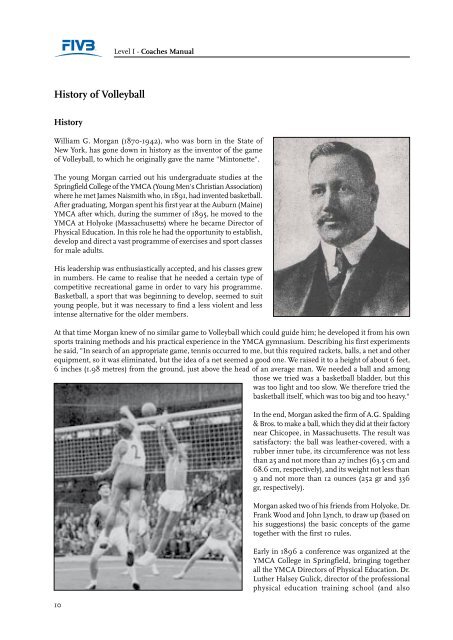COACHES MANUAL
Download
Download
- No tags were found...
You also want an ePaper? Increase the reach of your titles
YUMPU automatically turns print PDFs into web optimized ePapers that Google loves.
Level I - Coaches Manual<br />
History of Volleyball<br />
History<br />
William G. Morgan (1870-1942), who was born in the State of<br />
New York, has gone down in history as the inventor of the game<br />
of Volleyball, to which he originally gave the name "Mintonette".<br />
The young Morgan carried out his undergraduate studies at the<br />
Springfield College of the YMCA (Young Men's Christian Association)<br />
where he met James Naismith who, in 1891, had invented basketball.<br />
After graduating, Morgan spent his first year at the Auburn (Maine)<br />
YMCA after which, during the summer of 1895, he moved to the<br />
YMCA at Holyoke (Massachusetts) where he became Director of<br />
Physical Education. In this role he had the opportunity to establish,<br />
develop and direct a vast programme of exercises and sport classes<br />
for male adults.<br />
His leadership was enthusiastically accepted, and his classes grew<br />
in numbers. He came to realise that he needed a certain type of<br />
competitive recreational game in order to vary his programme.<br />
Basketball, a sport that was beginning to develop, seemed to suit<br />
young people, but it was necessary to find a less violent and less<br />
intense alternative for the older members.<br />
At that time Morgan knew of no similar game to Volleyball which could guide him; he developed it from his own<br />
sports training methods and his practical experience in the YMCA gymnasium. Describing his first experiments<br />
he said, "In search of an appropriate game, tennis occurred to me, but this required rackets, balls, a net and other<br />
equipment, so it was eliminated, but the idea of a net seemed a good one. We raised it to a height of about 6 feet,<br />
6 inches (1.98 metres) from the ground, just above the head of an average man. We needed a ball and among<br />
those we tried was a basketball bladder, but this<br />
was too light and too slow. We therefore tried the<br />
basketball itself, which was too big and too heavy."<br />
10<br />
In the end, Morgan asked the firm of A.G. Spalding<br />
& Bros. to make a ball, which they did at their factory<br />
near Chicopee, in Massachusetts. The result was<br />
satisfactory: the ball was leather-covered, with a<br />
rubber inner tube, its circumference was not less<br />
than 25 and not more than 27 inches (63.5 cm and<br />
68.6 cm, respectively), and its weight not less than<br />
9 and not more than 12 ounces (252 gr and 336<br />
gr, respectively).<br />
Morgan asked two of his friends from Holyoke, Dr.<br />
Frank Wood and John Lynch, to draw up (based on<br />
his suggestions) the basic concepts of the game<br />
together with the first 10 rules.<br />
Early in 1896 a conference was organized at the<br />
YMCA College in Springfield, bringing together<br />
all the YMCA Directors of Physical Education. Dr.<br />
Luther Halsey Gulick, director of the professional<br />
physical education training school (and also



